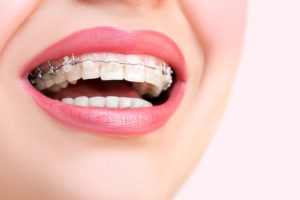 Braces can adjust the positioning of your teeth and jaw. A dental professional may recommend them to help align crooked teeth, modify the spacing between teeth, or correct a bad bite. When you have braces, small fixtures called brackets are attached to your teeth. A thin metal wire called an archwire runs through these brackets. The archwire is gradually adjusted to apply force, moving your teeth into the desired position. For braces to work effectively, the archwire must remain secured in the brackets. Traditional braces achieve this by using elastic bands or metal ties. In contrast, these braces use a system built into the bracket itself to hold the archwire.
Braces can adjust the positioning of your teeth and jaw. A dental professional may recommend them to help align crooked teeth, modify the spacing between teeth, or correct a bad bite. When you have braces, small fixtures called brackets are attached to your teeth. A thin metal wire called an archwire runs through these brackets. The archwire is gradually adjusted to apply force, moving your teeth into the desired position. For braces to work effectively, the archwire must remain secured in the brackets. Traditional braces achieve this by using elastic bands or metal ties. In contrast, these braces use a system built into the bracket itself to hold the archwire.
Generally, these braces take about the same amount of time to achieve the same results that you would get from the conventional treatment. On average, you’re looking at being in braces between 12 to 30 months.
The appointments themselves for these braces are roughly the same length as with traditional braces. The same is true of the intervals between appointments.
When you come in for an initial consultation and our orthodontist evaluates your condition, we will have a good idea of how long your treatment will take.
Since self-ligating braces don’t use elastic bands as conventional braces do, there are no colour choices where this part is concerned. However, you do have an option when it comes to the brackets themselves. Typically, these brackets are metal or silver in colour. For those that want a more discreet look, these braces also have the option to choose clear brackets.
Self-ligating braces vs. traditional braces
Self-ligating braces use a built-in system to secure the archwire to the brackets. You may also hear this system referred to as self-ligating brackets.
This ligation method is different from traditional braces, in which tiny elastic bands or metal ties are applied to the brackets to hold the archwire in place. These are called ligatures.
When discussing these braces, it’s important to know that there are actually two types of self-ligating brackets: active and passive. Both types use a small door or gate-like mechanism to close over the bracket:
Active brackets use a sliding spring clip mechanism. They press against the archwire, applying an active force.
Passive brackets use a simple sliding mechanism. Unlike active brackets, they don’t press on the archwire.
Like with traditional braces, these braces still require periodic adjustments. During these adjustments, your orthodontist will evaluate your progress and may also adjust or replace your archwire. Adjustments can modify the force placed on your teeth, helping them to gradually move into their new positions.
Like traditional braces, self-ligating braces can lead to pain or discomfort. This may be particularly common after you first get them, or after you’ve had an adjustment appointment. In some cases, self-ligating braces might cause less discomfort than traditional braces if the wearer ensures proper oral hygiene while wearing them. A 2014 study trusted Source compared quality of life in 150 people with either traditional or self-ligating braces. Researchers found that while people with traditional braces reported more pain than those with self-ligating braces, this difference between the two wasn’t statistically significant.
Benefits of self-ligating braces
- Shorter orthodontist visits. For traditional braces, individual ligatures must be replaced during an adjustment. Generally speaking, opening and shutting self-ligating brackets during an adjustment is less time-consuming.
- Easier cleaning. Ligatures can trap food particles in and around your brackets. The absence of ligatures in self-ligating braces may make them a little easier to clean.
- Less discomfort. It’s possible that you might experience less discomfort with self-ligating braces than with traditional braces.
The downside
With their many benefits, these braces may be the solution some patients are searching for. However, as with most good things, this system does come with its disadvantages.
Occasionally the hinges on the brackets of these braces will give out and the doors won’t stay shut. If this happens, we may need to replace the bracket or tie it down.
While self-ligating braces are slightly easier to clean than the traditional option, they will still require special attention and tools during your daily oral hygiene routine. Developing cavities and gum issues are a serious side effect of not properly cleaning your teeth while you have braces of any type.
Another disadvantage to these braces is that while you can get clear brackets, there’s no way to do away with metal altogether since the wires are metal. This can be very bothersome to those patients that are extremely conscious about the appearance of having braces.
If you or your child don’t have the best habits when it comes to taking care of your teeth, or would feel embarrassed by wearing metal braces, then you may want to consider another orthodontic option. In this case, Invisalign clear aligner therapy may be the solution for you.
Read more about braces :











